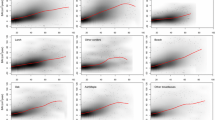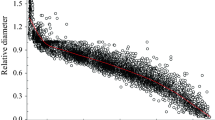Abstract
One of the aims of this work is to describe how the target variable “tree vitality” in terms of needle loss is affected by other explanatory variables. To describe such a relationship in a realistic way, we use generalized additive mixed models (GAMMs) which allow to take spatial correlation of the data into account and in addition allow the inclusion of explanatory variables as predictors with the possibility of having non-linear effects. The GAMMs are fitted in a Bayesian framework using Markov chain Monte Carlo techniques. Data are available for two years 1988 and 1994. We select a set of best explanatory variables from a large set of variables including tree-specific variables, such as species, age, nutrients in the needles and site-specific variables such as altitude, relief type, soil depth and content of different nutrients in the top soil. In the two models for 1988 and 1994, different sets of explanatory variables were selected as best predictors. In both models, the effects of explanatory variables allowed a plausible interpretation. For example, the site-specific variables such as relief and soil depth were significant predictors, since these factors determine how well water and nutrient supply is balanced at a specific site. The selected sets of explanatory variables differed between 1988 and 1994, giving an indication of a possible change in the main causes of forest deterioration between 1988 and 1994. From the set of nutrient variables measured in the soil and in the needles, in 1988 altitude a.s.l. and magnesium supply were among the explanatory variables, in 1994 a combination of Al in the soil and the N/K-ratio (in the needles) was selected in the model. In 1988 altitude a.s.l. was among the most important predictors in the model. This is in contrast to 1994 where altitude was not selected. This may have to do with the fact that in the early phase of forest health monitoring (1988) one of the main causes of forest deterioration was magnesium deficiency. Later on this may have changed to a combination of soil acidification and nitrogen eutrophication. Thus by using an adequate model such as the GAMM, sets of explanatory variables for needle loss may be identified. By fitting two GAMMs, with different sets of “best” predictors, at two time points 1988 and 1994, we can detect changes in these sets of “best” predictors over time. This allows us to use the monitoring data with the tree vitality indicator crown condition/needle loss as a tool for forest health management, which may involve decisions about concrete counter measures like e.g. forest liming.








Similar content being viewed by others
References
Albert J, Chibs S (1993) Bayesian analysis of binary and polychotomous response data. J Am Stat Assoc 88:669–679
Augustin NH, Lang S, Musio M, von Wilpert K (2005a) A spatial model for the needle losses of pine trees in the forests of Baden-Wuerttemberg: an application of Bayesian structured additive regression. J R Stat Soc C (Appl Stat). Invited for resubmission
Augustin NH, Kublin E, Metzler B, Meierjohann E, von Wuehlisch G (2005b) Analysing the spread of beech canker. Forest Sci 51(5):438–448
Augustin NH, Sauerbrei W, Schumacher M (2005c) The practical utility of incorporating model selection uncertainty into prognostic models for survival data. Stat Model 5:95–118
Banerjee S, Carlin BP, Gelfand AE (2004) Hierarchical modelling and analysis for spatial data. Chapman & Hall, London
BML (1990) Bundesministerium für Ernährung, Landwirtschaft und Forsten (Hrsg.), Bund-/Länderarbeitsgruppe BZE: Bundesweite Bodenzustandserhebung im Wald, Arbeitsanleitung. 147 S
Besag J, York J, Mollie A (1991) Bayesian image restoration, with two applications in spatial statistics (with discussion). Ann Inst Stat Math 43:1–59
Chatfield C (1995) Model uncertainty, data mining and statistical inference. J R Stat Soc A 158:419–466
Cronan CS, Grugal DF (1995) The use of calcium/aluminium ratios as indicators of stress in forest ecosystems. J Environ Qual 24:209–226
De Vries W, Forsius M, Lorenz M, Lundin L, Haussmann Th, Augustin S, Ferretti M, Kleemola S, Vel E (2002) Cause–effect relationships of forest ecosystems: joint report by ICP forests and ICP integrated monitoring. UN/ECE, Genova, pp 46
Diaz-Avalos C, Peterson DL, Alvardado E, Ferguson SA, Besag JE (2001) Space–time modelling of lightning-caused ignitions in the Blue Mountains, Oregon, Canada. J Forest Res 31:1579–1593
Ellenberg H (1995) Neuartige Waldschäden? Ökologische Kritik an den Untersuchungsmethoden. AFZ 50(15):796–797
Ellenberg H (1997) Sogenannte, “Blattverluste” = kein sicheres Maß für Waldschäden. SDW: Unser Wald (1):4–6
Evers FH (1985) Nomograms for classifying the nutrition supply of needles and leaves. Internal technical paper at the Forest Research Institute, Freiburg
Evers FH (1994) Magnesiummangel, eine verbreitete Erscheinung in Waldbeständen: Symptome und analytische Schwellenwerte. Mittl. d. Vereins f. Forstl. Standortskartierung. u. Forstplan zenzüchtung 37:7–15
Evers FH, Schöpfer W (1988) Ergebnisse der Belastungsinventur Baden-Württemberg 1983. Mitt. der Forstl. Vers. u. Forschungsanst 188
Evers FH, Schöpfer W, Mikloss J (1968) Die Zusammenhänge zwischen Stickstoff-, Phosphor- und Kalium–Mengen und den C/N-, C/P- und C/K—Verhältnissen der Oberböden von Waldstandorten. Mitteilungen des Vereins für Standortkunde und Forstpflanzenzüchtung, Nr 18
Fahrmeir L, Lang S (2001) Bayesian inference for generalized additive mixed models based on Markov random field priors. J R Stat Soc C 50:201–220
Feger KH, Raspe S (1992) Ernährungszustand von Fichtennadeln und—wurzeln in Abhängigkeit vom Nährstoffangebot im Boden. Forstw Cbl 111:73–76
Gilks WR, Richardson S, Spiegelhalter DJ (1996) Markov chain Monte Carlo in practice. Chapman & Hall, London
Gülpen M, Feger KH (1998) Magnesium- und Calcium-Ernährung von Hochlagenfichten: Vergilbungszustand und Reaktion auf unterschiedliche Düngung. Z Pflanzenernährung Bodenkunde 161(6):671–679
Hildebrand EE (1994) N deposition as a site factor for forest stands in Southwest Germany. Nova Acta Leopoldina NF70 288:418–424
Hoeting JA, Madigan D, Raftery AE, Volinsky CT (1999) Baysian model averaging: a tutorial (with discusssion). Stat Sci 14:382–417
Hüttl R (1991) Die Nährelementversorgung geschädigter Wälder in Europa und Nordamerika. Freiburger Bodenkundl Abh 28:440
Lang S, Brezger A (2004) Bayesian P-splines. J Comput Graphical Stat 13:183–212
Landmann G, Bonneau M (eds) (1995) Forest decline and atmospheric deposition effects in the French mountains. Springer, Berlin Heidelberg New York, p 461
Mohr H (1994) Stickstoffeintrag als Ursache neuartiger Waldschäden. Spectrum der Wissenschaft 1(94):48–53
Mengel K (1991) Ernährung und Stoffwechsel der Pflanze. G Fischer, Jena. 466
Musio M, Augustin N and von Wilpert K (2006) Geoadditive models for forestry defoliation data: a case study (in press)
Rost-Siebert K (1983) Aluminium—Toxizität und—Toleranz an Keimpflanzen von Fichte (Picea abies Karst.) und Buche (Fagus silvatica L.). AFZ 26/vg27:686–689
Rost-Siebert K (1988) Ergebnisse vegetationskundlicher und bodenchemischer Vergleichsuntersuchungen zur Feststellung immissionsbedingter Veränderungen während der letzten Jahrzehnte. Ber. Forschungszentr. Waldökosysteme Göttingen. B8, pp 158
Schöpfer W, Hradetzky J (1984) Der Indizienbeweis: Luftverschmutzung maßgebliche Ursache der Walderkrankung. FwCbl 103:231–248
Spiegelhalter DJ, Best N, Carling BP, van der Linde A (2002) Bayesian measure of model complexity and fit (with discussion). J R Stat Soc B 64:583–639
Sverdrup H (1995) Critical loads and the BC/Al-ratios as indicator of soil acidification effects on tree growth. Kungl + Skogs och Lantbruksakademiens Tidskrift 134(11):77–98
Sverdrup H, Warvinge P (1993) The effect of soil acidification on the growth of trees, grass, herbs as expressed by the (Ca + Mg + K)/Al ratio. Report in Ecology and Environmental Engineering 2. Lund, Lund University, Department of Chemical Engineering II, pp 42
Ulrich B (1992) Forest ecosystem theory based upon material balance. Ecological Model 63:163–183
Ulrich B (1995) The history and possible causes of forest decline in central Europe, with particular attention to the German situation. Environ Rev 3(3, 4):262–276
Ulrich B, Cronan CS, Wolters V, Schaefer M, Eichhorn J, Worrall JJ, Rapp C, Jentschke G, Gruber F, Roloff A, Godbold DL, Hüttermann A (eds) (1994) Effects of acid rain on forest processes. Wiley-Liss, New York, p 419
von Wilpert K (2000) Neue Entwicklung in der Waldernährung. Forstliche Versuchs- und Forschungsanstalt Baden-Wuerttemberg. Jahresbericht 1999, pp 33–36
von Wilpert K (2003) Drift des Stoffhaushalts im Fichten—Düngeversuch Pfalzgrafen weiler. AFJZ 174(2/3):21–30
von Wilpert K, Lukes M (2003) Ecochemical effects of phonolite rock powder, dolomite and potassium sulfate in a spruce stand on an acidified glacial loam. Nutrient cycling in agroecosystems. Kluwer, Dordrecht, vol 65, pp 115–127
Zech W, Popp E (1983) Magnesiummangel, einer der Gründe für das Fichten- und Tannensterben in -NO-Bayern. Forstwiss Centralblatt 102:50–55
Zeger SL, Karim MR (1993) Generalized linear models with random effects: a Gibbs sampling approach. J Am Stat Assoc 86:79–86
Zirlewagen D (2003) Regionalisierung bodenchemischer Eigenschaften in topographisch stark gegliederten Waldlandschaften. Freiburger Forstliche Forschung, Band 19, pp 154
Zirlewagen D, von Wilpert K (2004) Using model scenarios to predict and evaluate forest management impacts on soil base saturation at landscape level. Eur J For Res 123(4):269–282
Acknowledgments
The work was supported by the BMBF-research project number 0339985. We thank Edgar Kublin for his helpful contributions. Moreover, we are grateful for the quick and helpful second review.
Author information
Authors and Affiliations
Corresponding author
Additional information
Communicated by Hans Pretzsch
Rights and permissions
About this article
Cite this article
Musio, M., von Wilpert, K. & Augustin, N.H. Crown condition as a function of soil, site and tree characteristics. Eur J Forest Res 126, 91–100 (2007). https://doi.org/10.1007/s10342-006-0132-8
Received:
Accepted:
Published:
Issue Date:
DOI: https://doi.org/10.1007/s10342-006-0132-8




